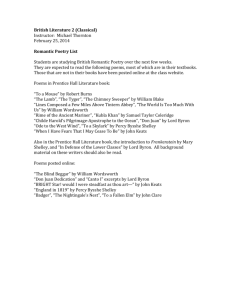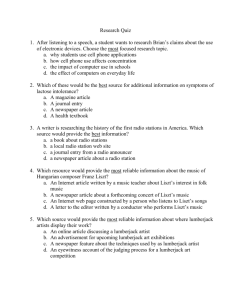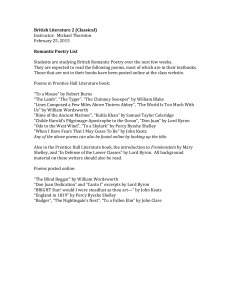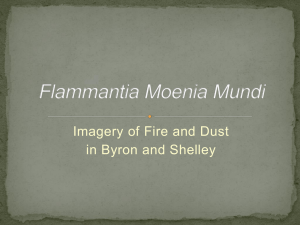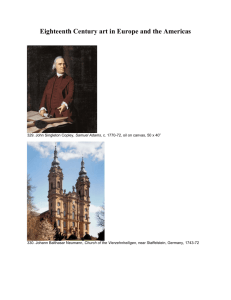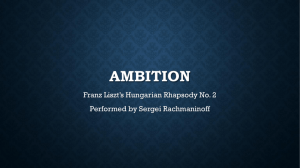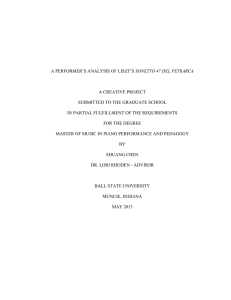Romanticism
advertisement
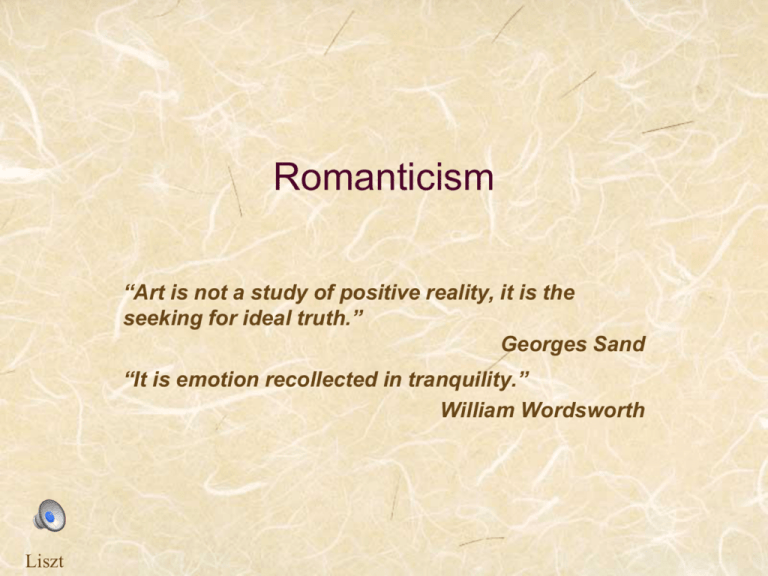
Romanticism “Art is not a study of positive reality, it is the seeking for ideal truth.” Georges Sand “It is emotion recollected in tranquility.” William Wordsworth Liszt Romanticism Spontaneous personal emotion and its expression; irrationality History and nostalgia for the past Death, mystery, the supernatural Exoticism and celebration of romantic love Enthusiasm for nature Artist as individual - free spirits, apart from the masses - no longer craftsmen serving society but free spirits expressing their own souls with a genius not granted to the common run of humanity Predecessors Jean-Jacques Rousseau French (1712-1778) Emile; The Social Contract Modernity is to the detriment of character; action should be based on morals, not reason; man in his natural state is ideal; people must give their consent to be governed, forming the “social contract.” Immanuel Kant German (1724-1804) - Critique of Pure Reason Life must be understood as being based on the presence of God. “I had to abolish knowledge, in order to make room for faith.” Liszt Ties Mary Shelley Frankenstein English (1797-1851) Percy Shelley’s wife; Byron’s lover; Blake’s friend Alexander Dumas The Three Musketeers French(1802-1870) friend of Hugo, Sand, Liszt, Rossini Victor Hugo The Hunchback of Notre Dame French (1802-1885) friend of Dumas, Sand, Liszt, Rossini Georges Sand The Haunted Pool; Isadora lover of Chopin, Delacroix, Liszt John Keats To Sleep lover; dies of TB French (1804-1876) English (1795-1821) Percy Shelley’s Percy Bysshe Shelley Ode to the West Wind English (1792-1822) Mary Shelley’s husband, Byron’s lover; Keats lover; dies in mishap at sea Lord Byron Sardanapalus, Childe Harold’s Pilgrimage English (1788-1824) Percy Shelley’s lover; Keats lover; Caroline Lamb’s lover, along with half-sister Augusta and her half sister Caroline, etc.; dies in war of Greek Independence Ties Frederic Chopin Etude in C Minor Polish (1810-1849); friend of Delacroix, Liszt, Sand; dies of TB Franz Liszt Hungarian Rhapsody Hungarian (1811-1886); friends with Sand, Delacroix; Chopin; Hugo; Dumas; Rossini Hector Berlioz Symphonie Fantastique French (1803-1869); story of “idea fixe,” opiate dreams based on his unrequited love for Irish actress Harriet Smithson, whom he married five years later, with Liszt as his witness); friend of Liszt and Mendelssohn Gioacchino Rossini Italian (1792-1868) William Tell; Barber of Seville; friend of Liszt, Sand, Delacroix, Chopin, Hugo, Dumas ________________________ Lines Written in Early Spring English (17701850) detested Napoleon, thought Byron gifted but depraved; champion of the poor William Wordsworth Samuel Taylor Coleridge The Rime of the Ancient Mariner; Kubla Khan English (1772-1834) close friend of Wordsworth; opium addict Chopin Music Characteristics: Great dynamic range, importance of tone color, intensely subjective, emotionally expressive, highly individualistic. Beethoven is the bridge between Classical composition and Romantic. His Third Symphony (Eroica) marks his “heroic” period, where he celebrated the forces of history and the passions that create it. Romanticism is fully articulated in his Ninth Symphony. Robert Schumann German (1810-1856) Particularly known for his compositions for piano. Piano Concerto in A Minor; wife was pianist Clara Schumann, the object of Brahms lifelong love; life-long depressive; attempts suicide in 1854 and dies 2 years later. Frederic Chopin Polish (1810-1849) Also known for his compositions for piano. Incorporated traditional Polish folk themes and dances into his compositions. TB. Music Franz Schubert Austrian (1791-1828) Particularly known for his lieder. Quartet in A Minor; Elfking (Goethe’s poem). Erlkonig Who rides so late through the dark and wild? My daughters will cherish your youth and It is the father with his small child; beauty. He protects the boy in his proud arm, They will dance all night in a dizzy round, He holds him safely, he keeps him warm.- And then they’ll cradle you, safe and sound.” Son, why do you shiver? Your face is white! Father, O Father, why can’t you see I see the Elfking, a fearful sight! The Elfking’s dark daughters calling me? The Elfking, Father, in cloak and crown! - My son, my son, they’re only shadows, My son, it’s the mist, slow drifting down.- The tossing shapes of old gray willows. “You innocent child, just come away, “I love you, your beauty, child, your charm, So that together we two will play; So come with me, or I’ll do you harm!” The flowers on the strand are bright to behold; Father, O Father, he won’t let me go! My mother will dress you in cloth of gold” The Elfking’s hard hands have hurt me so! Father, O Father, why can’t you hear The father shudders, his eyes are wild, The Elfking whispering in my ear? - He holds in his arms the moaning child, Be still, my child, be safe, my nestling! He gallops for home; but drops his head. What you hear are the dry leaves rustling.- The boy he holds in his arms is dead. “My beautiful boy, come home with me! Music • Hector Berlioz French (1803-1869) The original author of Program Music: Symphonie Fantastique • Franz Liszt Hungarian (1811-1886) Particularly known for his compositions for piano and the Symphonic Poem. Hungarian Rhapsody • Gioacchino Rossini Italian (1792-1868) Author of bel canto opera: William Tell, Othello; Barber of Seville • Later: Mendelssohn and Brahms, then Wagner Berlioz Francisco Goya Spanish (1746-1828) Sleep of Reason Produces Monsters Francisco Goya Dona Teresa Sureda c. 1805 (110 kB); Oil on canvas, 119.8 x 79.4 cm (47 1/8 x 31 1/4 in); National Gallery of Art, Washington Francisco Goya Saturn Devouring His Son Oil on plaster transferred to canvas, 4' 9 1/8" x 2' 8 5/8"; Prado, Madrid Francisco Goya The Shooting of May Third, 1808 1814 Oil on canvas, 104 3/4 x 136 in; Museo del Prado, Madrid William Blake Pity, 1795 William Blake "I do not behold the outward creation... it is a hindrance and not action." The Whirlwind of Lovers c.1826 Birmingham Art Gallery Literature 18th century predecessors Johann Wolfgang von Goethe The Elfking William Blake Milton (p. 770); “Tyger! Tyger! burning bright In the forests of the night,” and The Sick Rose O Rose, thou art sick! The invisible worm That flies in the night In the howling storm Has found out thy bed Of crimson joy; And his dark crimson love Does thy life destroy William Blake Tyger, 1794 Alexander Pushkin (1799 -1837) Eugene Onegin (Piotr Tchaikovsky) Boris Godunuv; (Modest Mussorgsky) Queen of Spades Sir Walter Scott Scottish (1771-1832) Lochinvar Alexander Dumas (1802-1870) The Three Musketeers Victor Hugo (1802-1885) The Hunchback of Notre Dame Percy Bysshe Shelley (1792-1822) Ode to the West Wind Lord Byron (1788-1824) Childe Harold’s Pilgrimage William Wordsworth (1770-1850) Lines Written in Early Spring John Keats (1795-1821) To Sleep Georges Sand (1804-1876) The Haunted Pool; Isadora Samuel Taylor Coleridge (1772-1834) The Rime of the Ancient Mariner; Kubla Khan Edgar Allen Poe (1809-1849) invents mystery The Fall of the House of Usher; The City in the Sea Mary Shelley (1797-1851) Frankenstein Charlotte Bronte Emily Bronte Jane Eyre Wuthering Heights Henry Fuseli Lady Macbeth, 1794 Jean-Auguste Ingres French (1780-1867) Napoleon on his Imperial Throne, 1806 Beethoven Jean-Auguste Ingres French (1780-1867) Odalisque with a Slave, 1840 Oil on canvas mounted on panel, 29 3/8 x 39 3/8 in; Fogg Art Museum, Harvard University, Cambridge, MA Theodore Gericault French (1791-1824) The Raft of the Medusa, 1819 Eugene Delacroix Greece on the Ruins of Missolonghi 1827 Eugene Delacroix French (1798-1863) The Death of Sardanapal 1827 Musee du Louvre, Paris (inspired by poetry of Byron) Eugene Delacroix French (1798-1863) Liberty Leading the People Painted on 28 July 1830, to commemorate the July Revolution that had just brought Louis-Philippe to the French throne; Louvre. Caspar David Friedrich German (1774-1840) The Cross on the Mountain Kunstmuseum at Dusseldorf Schumann Caspar David Friedrich German (1774-1840) Solitary Tree 1823 Caspar David Friedrich German (1774-1840) Morning 1821; Oil on canvas, 22 x 30.5 cm; Niedersachsisches Landesmuseum, Hanover Caspar David Friedrich German (1774-1840) The Sea of Ice 1824/5 J. M. William Turner English (1775-1851) Rain, Steam and Speed 1844; Oil on canvas, 90.8 x 121.9 cm; National Gallery, London J. M. William Turner English (1775-1851) Slavers throwing overboard the Dead and Dying Typhoon coming on ("The Slave Ship") 1840; Oil on canvas, 90.8 x 122.6 cm; Museum of Fine Arts, Boston J. M. William Turner English (1775-1851) Mortlake Terrace: Early Summer Morning 1826 William Wordsworth (1770-1850) Lines Written in Early Spring I HEARD a thousand blended notes, While in a grove I sate reclined, In that sweet mood when pleasant thoughts Bring sad thoughts to the mind. The birds around me hopped and played, Their thoughts I cannot measure:-But the least motion which they made It seemed a thrill of pleasure. To her fair works did Nature link The human soul that through me ran; And much it grieved my heart to think What man has made of man. The budding twigs spread out their fan, To catch the breezy air; And I must think, do all I can, That there was pleasure there. Through primrose tufts, in that green bower, The periwinkle trailed its wreaths; And 'tis my faith that every flower Enjoys the air it breathes. If this belief from heaven be sent, If such be Nature's holy plan, Have I not reason to lament What man has made of man? Thomas Cole American (1801-1848) The Voyage of Life: Childhood 1839 Thomas Cole American (1801-1848) The Voyage of Life: Youth 1839 Samuel Taylor Coleridge (1772-1834) The Rime of the Ancient Mariner; Kubla Khan, or a Vision in a Dream. A Fragment. In Xanadu did Kubla Khan A stately pleasure-dome decree: Where Alph, the sacred river, ran Through caverns measureless to man Down to a sunless sea. So twice five miles of fertile ground With walls and towers were girdled round: And there were gardens bright with sinuous rills, Where blossomed many an incense-bearing tree; And here were forests ancient as the hills, Enfolding sunny spots of greenery. But oh! that deep romantic chasm which slanted Down the green hill athwart a cedarn cover! A savage place! as holy and enchanted As e'er beneath a waning moon was haunted By woman wailing for her demon-lover! And from this chasm, with ceaseless turmoil seething, As if this earth in fast thick pants were breathing, A mighty fountain momently was forced: Amid whose swift half-intermitted burst Huge fragments vaulted like rebounding hail, Or chaffy grain beneath the thresher's flail: And 'mid these dancing rocks at once and ever It flung up momently the sacred river. Five miles meandering with a mazy motion Through wood and dale the sacred river ran, Then reached the caverns measureless to man, And sank in tumult to a lifeless ocean: And 'mid this tumult Kubla heard from far Ancestral voices prophesying war! The shadow of the dome of pleasure Floated midway on the waves; Where was heard the mingled measure From the fountain and the caves. It was a miracle of rare device, A sunny pleasure-dome with caves of ice! A damsel with a dulcimer In a vision once I saw: It was an Abyssinian maid, And on her dulcimer she played, Singing of Mount Abora. Could I revive within me Her symphony and song, To such a deep delight 'twould win me That with music loud and long I would build that dome in air, That sunny dome! those caves of ice! And all who heard should see them there, And all should cry, Beware! Beware! His flashing eyes, his floating hair! Weave a circle round him thrice, And close your eyes with holy dread, For he on honey-dew hath fed And drunk the milk of Paradise. Thomas Doughty American (1793-1856) View of the Susquehanna, 1832 Oil on canvas, 18 1/8 x 24 1/8 in. BYU Thomas Doughty American (1793-1856) Carolina Swamp, 1825 oil on canvas laid on board, 24"x36" image, s.l.l. and… Camille Corot French (1796-1875) Hippolyte Flandrin French (1809-1864) Jacques Louis David French (1748-1825) The earliest photography, of Louis Jacques Mande Daguerre and William Henry Fox Talbot, would change art forever. Oriel window in the South Gallery at Lacock Abbey, Wiltshire Talbot, August, 1835 Schumann Daguerre, 1839 REALISM Gustave Courbet, the foremost Realist painter, believed that painters should paint only their own time and that "painting is an essentially concrete art, and can consist only of representation of real and existing things." Realists wanted to give an accurate and apparently objective description of the ordinary, observable world. Honore Daumier The Uprising 1860 REALISM Often Realist art and literature had a distinct agenda of social and political reform, ranging from moderate, as in the case of Charles Dickens, to radical politics, as in the case of Courbet. Pierre-joseph Proudhon et ses Enfants 1865 Gustave Courbet French (1819-77) The Wounded Man 1844-54 Musee d'Orsay Gustave Courbet French (1819-77) The Stone Breakers, 1849-50 Jean-Francois Millet French (1814-1875) The Gleaners, 1857


